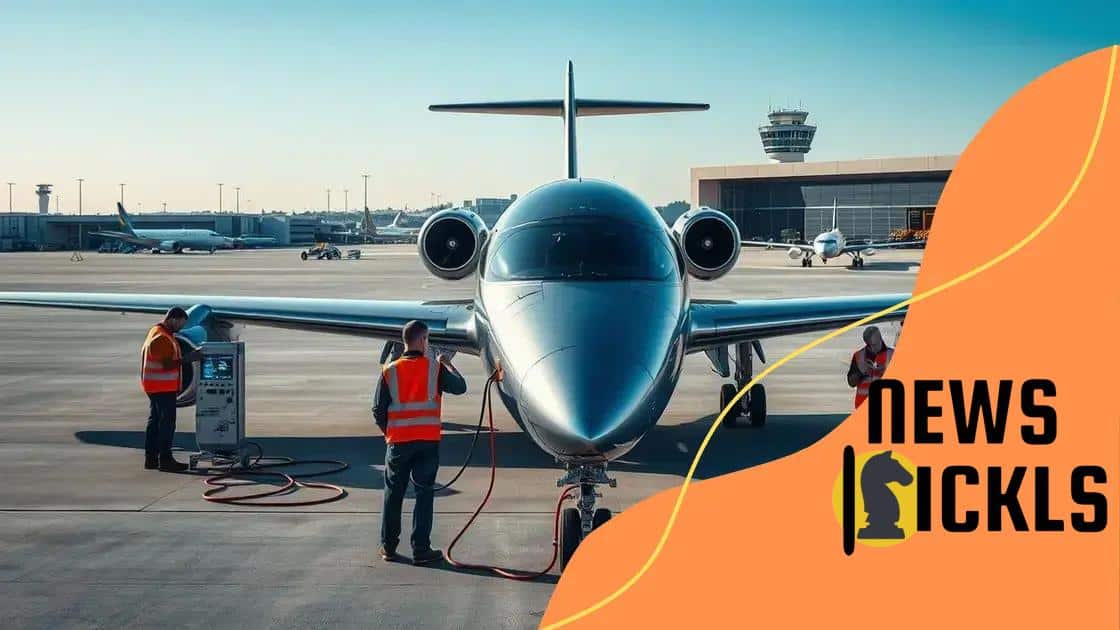The rise of electric aviation and its environmental impact

The rise of electric aviation significantly reduces emissions and noise pollution while promising cleaner, more efficient air travel through technological advancements, regulatory support, and growing public demand for sustainable options.
The rise of electric aviation and its environmental impact is a topic gaining traction as we seek sustainable solutions for air travel. Have you ever considered how electric planes could change your travel experience? Let’s dive deeper into this evolving industry.
Understanding electric aviation technology
Understanding electric aviation technology is essential as we move towards a more sustainable future in air travel. This technology enables aircraft to operate with less environmental impact, providing a cleaner alternative to traditional fuel-based aviation. By utilizing electric engines, we can significantly reduce carbon emissions, making air travel greener.
The Basics of Electric Aviation
Electric aviation relies on technologies that have evolved rapidly over the past few years. It includes various types of aircraft, from small drones to larger passenger planes. The core components of this technology include:
- Electric Motors: These are much quieter and more efficient compared to traditional jet engines.
- Battery Technology: Advanced batteries provide the energy needed for flight, with ongoing research aiming to improve their capacity and recharge times.
- Charging Infrastructure: As electric planes become more common, the development of reliable charging stations is crucial.
- Lightweight Materials: New materials help to reduce aircraft weight, enhancing energy efficiency.
Many companies are investing in electric aviation due to its potential. By decreasing fuel consumption, the cost of air travel can also drop. Imagine a future where flying is not only more efficient but also affordable for more people.
Environmental Benefits of Electric Aircraft
One of the most significant advantages of electric aviation is its positive impact on environmental sustainability. Electric planes produce less noise, which is particularly beneficial for communities near airports. Additionally, the reduction of greenhouse gas emissions plays a crucial role in combating climate change.
As we explore the potential of electric aviation, it’s important to consider how this technology can transform the entire aviation landscape. With advancements in battery life and energy efficiency, the dream of widespread electric flights might become a reality sooner than we expect. By investing in training and infrastructure, communities can support this transition effectively.
Ultimately, understanding electric aviation technology opens the door to a greener future in travel. With continued innovation, we can hope for a world where flying is both accessible and environmentally friendly.
Environmental benefits of electric planes
The environmental benefits of electric planes are significant and worth exploring. As air travel contributes to climate change, electric aviation presents a solution to reduce emissions. By switching to electric aircraft, we can improve the quality of air around airports and reduce noise pollution.
Reduction of Carbon Emissions
One of the most prominent advantages of electric planes is the reduction of carbon emissions. Unlike traditional aircraft that burn fossil fuels, electric planes operate on batteries, resulting in minimal to zero emissions during flight. This shift can drastically lower the environmental impact of air travel.
- Cleaner Air: With less smoke and pollutants, communities near airports can enjoy improved air quality.
- Lower Noise Pollution: Electric motors operate much quieter than jet engines, reducing noise-related disturbances.
- Sustainable Energy Sources: Electric planes can be charged using renewable energy, further decreasing their carbon footprint.
- Enhanced Fuel Efficiency: Electric engines are more efficient, allowing for better energy use in flights.
As innovation progresses, the technology behind electric planes improves as well. Currently, we witness ongoing research to enhance battery life and efficiency. Companies are motivated to explore how renewable energy can power these aircraft, promoting a more sustainable aviation future.
A Positive Impact on Wildlife
The shift to electric aviation also benefits wildlife. Traditional aircraft can disrupt local ecosystems due to noise and pollution. By reducing noise, electric planes can allow wildlife to thrive without stressing them. This is a crucial aspect in regions where aviation is close to natural habitats.
Ultimately, the environmental benefits of electric planes can foster a more sustainable future. As we work towards cleaner energy solutions, electrifying the skies is a vital step forward in making air travel both efficient and eco-friendly. With this technology, we can envision a world where travel does not come at the expense of our planet.
Challenges facing the adoption of electric aviation

Challenges facing the adoption of electric aviation are numerous and complex. While the technology holds great promise for a sustainable future, several barriers hinder its widespread implementation. These challenges need to be addressed to fully realize the benefits of electric planes.
Technological Hurdles
One of the main challenges is the technology itself. Current battery technology poses limitations on range and weight. Electric aircraft typically have a shorter range compared to conventional planes, which can limit their use for longer flights. Additionally, battery weight can impact the overall efficiency and performance of the aircraft.
- Battery Capacity: Current batteries may not hold enough charge for long flights.
- Charging Times: Unlike refueling, which is quick, charging can take hours.
- Infrastructure Needs: Airports must develop new systems to accommodate electric planes.
- Safety Standards: New technology must meet high safety standards.
As research and development continue, these technological barriers are likely to diminish. Innovative solutions, such as advances in battery chemistry and energy management systems, are essential for progress.
Economic Factors
The economic aspects of electric aviation also present significant challenges. Initial development and production costs for electric airplanes can be high. Manufacturers face the burden of heavy investment in new technologies and infrastructure while ensuring competitive pricing.
Furthermore, airlines must consider the operational costs and potential savings associated with electric planes. While electric aircraft can save on fuel costs, the initial purchase and transition costs can be a hard sell. Governments can play a key role by providing incentives and subsidies to support the shift to electric aviation.
Addressing these economic factors is crucial for accelerating the adoption of electric planes. As more stakeholders recognize the long-term benefits, the industry may begin to see a shift in investment and public support.
Lastly, public perception and regulatory issues can also influence the pace of adoption. Environmental concerns and aviation safety are vital topics that need to be part of the conversation as electric aviation continues to develop.
Impact on aviation industry jobs
The impact of electric aviation on industry jobs is a crucial consideration as the field evolves. As electric planes become more common, they will create both new opportunities and challenges in the workforce. Understanding this shift can help us prepare for the future of aviation.
New Job Opportunities
Electric aviation is set to transform the aviation landscape. As manufacturers ramp up production of electric aircraft, new roles will emerge. Jobs related to the development, production, and maintenance of electric planes will likely increase. This shift can lead to:
- Engineers: More engineers will be needed to design advanced electric propulsion systems.
- Technicians: Specialists who understand electric systems and battery technology will be in high demand.
- Charging Infrastructure Workers: New roles will focus on building and maintaining charging stations at airports.
- Research and Development Positions: Ongoing innovation will require skilled researchers to enhance electric aviation technology.
These new job roles can significantly contribute to the economy and create a more skilled workforce in aviation.
Job Displacement Concerns
While electric aviation presents new job opportunities, it may also lead to displacement in certain areas. Traditional aircraft jobs might be affected as the industry shifts towards automation and electric systems. For instance, as simple maintenance tasks become automated, some roles may diminish. To navigate this transition, it is vital to:
- Upskill Workers: Existing professionals can learn new skills related to electric aviation.
- Provide Training Programs: Educational institutions can establish programs focused on electric engine technology.
- Encourage Transition Programs: Companies can offer assistance for workers moving to new roles.
Addressing these concerns thoughtfully can ensure a smoother transition for those affected by industry changes.
In conclusion, the rise of electric aviation will undoubtedly have profound impacts on aviation industry jobs. By recognizing both the opportunities and challenges, we can better prepare for a future where flying is cleaner and more efficient.
Future prospects for electric aviation
Future prospects for electric aviation look promising as technology advances and environmental concerns rise. The aviation industry is beginning to embrace electric aircraft, which can lead to a more sustainable and efficient way of flying. Many experts believe we are on the brink of a major transformation.
Technological Innovations
As time progresses, we can expect significant innovations in battery technology and electric propulsion systems. These advancements will likely improve the range and performance of electric planes, making them a feasible alternative to traditional aircraft for more types of flights. Some potential innovations include:
- Solid-State Batteries: These batteries may provide higher energy density and faster charging times.
- Hybrid Systems: Combining electric and conventional engines could extend the range of electric flights.
- Improved Aerodynamics: New designs will enhance fuel efficiency and reduce drag.
- Renewable Energy Integration: Using solar or wind energy for charging may further reduce emissions.
Technological innovations are essential to making electric aviation competitive in the marketplace.
Regulatory Support
The role of governments and regulatory agencies will be crucial for the industry’s success. Supportive policies can encourage investment in electric aviation. Initiatives may include:
- Incentives for Research: Funding for companies developing electric aviation technologies can accelerate growth.
- Safety Regulations: Establishing clear and streamlined regulations for electric aircraft can foster innovation.
- Subsidies for Charging Infrastructure: Investments in charging stations will be necessary to support electric flight.
- Green Aviation Goals: Setting targets for reducing emissions can motivate the industry to transition.
Regulatory support can create a favorable environment for electric aviation to flourish.
Moreover, public interest in sustainable travel is on the rise. Consumers are increasingly seeking eco-friendly alternatives, driving companies to adopt electric solutions. As the market grows, we can anticipate more collaborations between traditional airlines and electric aircraft manufacturers, paving the way for diverse flight options.
With a combination of technological advancements, regulatory support, and public interest, the future of electric aviation holds tremendous potential. We may soon witness a quieter, cleaner, and more efficient way to travel the skies.
The future of electric aviation is bright and full of promise. As this technology evolves, we can expect to see cleaner, more efficient air travel. With ongoing innovations, supportive regulations, and growing public interest in sustainable practices, the transition to electric planes will likely reshape the aviation industry. As we embrace these changes, we pave the way for a healthier planet and a more exciting future in flying.
FAQ – Frequently Asked Questions about Electric Aviation
What are the main benefits of electric aviation?
Electric aviation offers reduced emissions, quieter flights, and improved air quality, making air travel more sustainable.
What challenges does the electric aviation industry face?
The industry faces hurdles like battery technology limitations, high initial costs, and the need for new infrastructure.
How will electric aviation impact jobs in the industry?
Electric aviation may create new jobs in engineering and maintenance while displacing some traditional roles, requiring upskilling for workers.
What future advancements can we expect in electric aviation?
Future advancements may include improved battery technology, hybrid systems, and increased regulatory support to facilitate growth.






